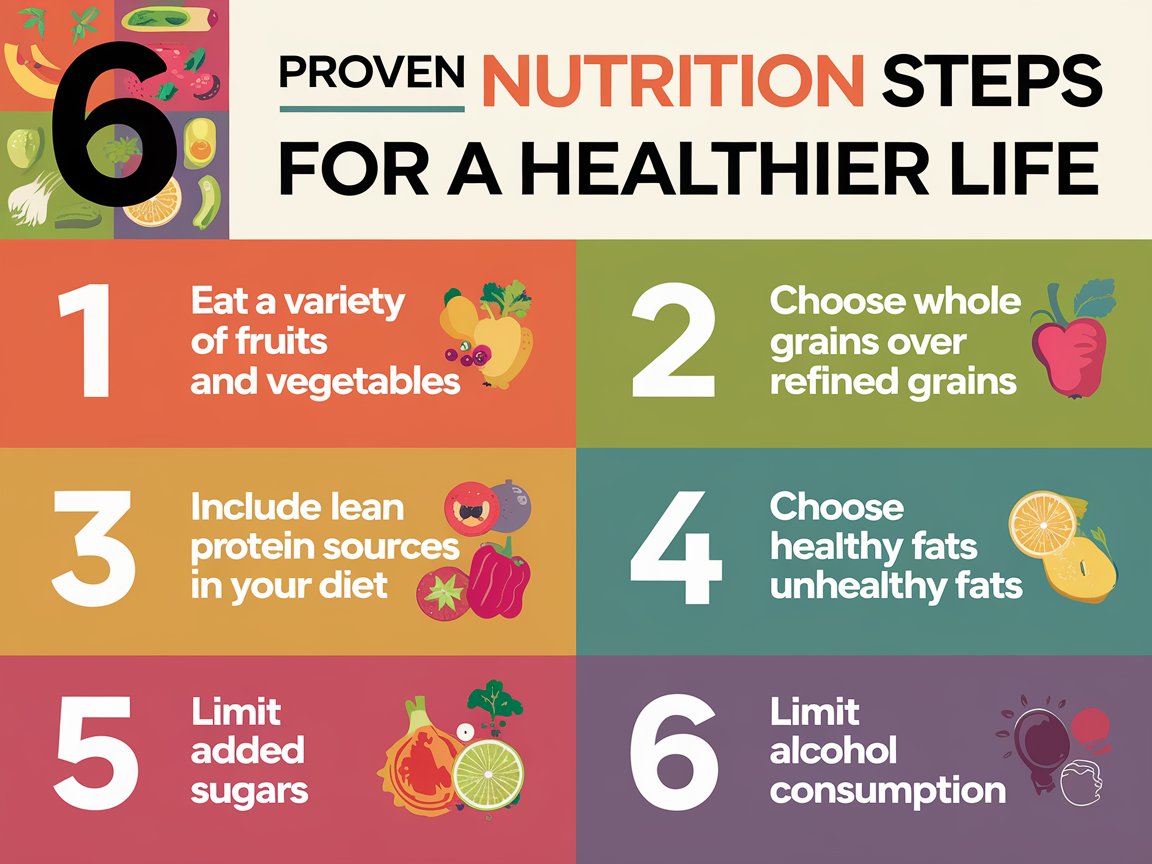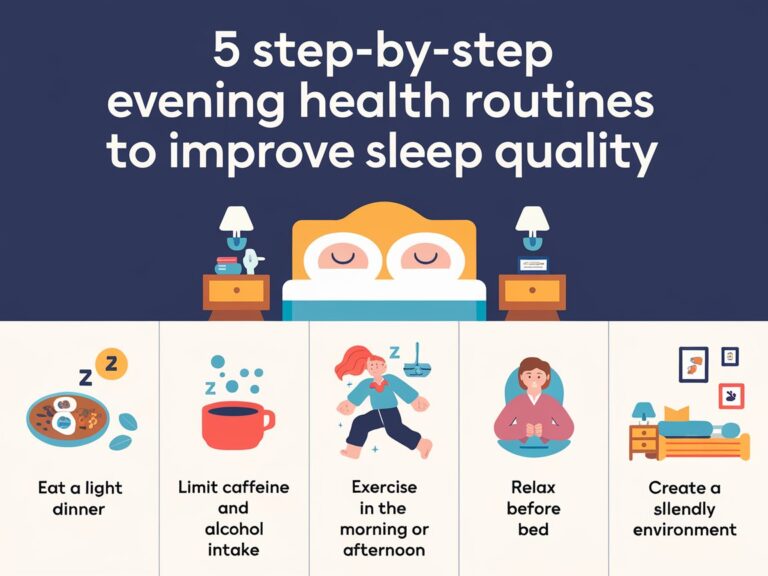6 Proven Nutrition Steps for a Healthier Life: Building a Balanced Diet
In our fast-paced modern world, maintaining a healthy diet can feel like a daunting task. However, nutrition plays a vital role in our overall well-being, influencing everything from our energy levels to our mood and even our longevity. This article outlines six proven nutrition steps that can help you build a balanced diet, promoting a healthier life.
Step 1: Incorporate a Variety of Whole Foods
The foundation of any balanced diet is a diverse range of whole foods. Whole foods are minimally processed and retain their natural nutrients, making them essential for good health.
- Diverse Food Groups: Aim to include a variety of food groups in your meals: whole grains, fruits, vegetables, lean proteins, and healthy fats. Each food group provides unique nutrients vital for your body’s functions. For example, fruits and vegetables are rich in vitamins, minerals, and antioxidants, which help fight inflammation and boost your immune system.
- Gut Health: A diverse diet also supports your gut microbiome, the community of bacteria in your digestive system that influences digestion, immunity, and even mental health. Research suggests that a varied diet can enhance the diversity of gut bacteria, leading to improved overall health.
- Practical Tips: To incorporate more whole foods into your diet, focus on shopping the perimeter of the grocery store, where fresh produce, meats, and dairy are usually located. Experiment with new fruits and vegetables each week and consider incorporating whole grains like quinoa, brown rice, and barley into your meals.
Step 2: Prioritize Portion Control
Even the healthiest foods can contribute to weight gain if consumed in excessive amounts. Understanding portion sizes is crucial for maintaining a healthy weight and promoting balanced nutrition.
- Understanding Portions: Familiarize yourself with standard portion sizes to avoid overeating. For example, a serving of cooked rice is typically about one cup, while a serving of meat should be about the size of your palm. Keeping these measurements in mind can help you gauge your intake.
- Mindful Eating: Practicing mindful eating can enhance your awareness of portion sizes. This involves paying attention to what you’re eating and savoring each bite. Try to minimize distractions while eating, such as watching TV or scrolling through your phone, which can lead to overeating.
- Practical Tips: Use smaller plates and bowls to make portion sizes look larger, which can help you feel satisfied with less food. Additionally, listen to your body’s hunger and fullness cues—stop eating when you feel satisfied, not stuffed.
Step 3: Choose Lean Proteins and Plant-Based Options
Proteins are essential for muscle repair, immune function, and overall health. However, not all protein sources are created equal.
- Lean Proteins: Incorporate lean protein sources like poultry, fish, eggs, and low-fat dairy. These options provide the necessary protein without the excess saturated fat found in some red meats.
- Plant-Based Proteins: Consider adding more plant-based proteins to your diet. Foods like beans, lentils, tofu, and nuts are rich in protein and provide additional nutrients such as fiber and healthy fats. Plant-based diets have been associated with numerous health benefits, including a lower risk of heart disease and certain cancers.
- Practical Tips: Aim to fill half your plate with vegetables and plant-based proteins at least once a day. Try experimenting with meatless meals, such as stir-fried tofu with vegetables or chickpea salads, to increase your plant-based intake.
Step 4: Emphasize Healthy Fats
Not all fats are bad. In fact, healthy fats are vital for your body’s functions, including hormone regulation and brain health.
- Healthy Fats: Focus on monounsaturated and polyunsaturated fats, which can help lower bad cholesterol levels. Sources include olive oil, avocados, nuts, and fatty fish like salmon and mackerel, which are high in omega-3 fatty acids.
- Avoid Unhealthy Fats: Limit your intake of trans fats (found in many processed foods) and reduce saturated fats (found in red meat and full-fat dairy). These types of fats can contribute to heart disease and other health issues.
- Practical Tips: Use olive oil as your primary cooking fat and add avocado to salads and sandwiches for a creamy texture and healthy fat boost. Incorporate a handful of nuts or seeds into your snacks for added crunch and nutrition.
Step 5: Reduce Added Sugars and Refined Carbohydrates
Excess sugar and refined carbs can lead to weight gain, blood sugar spikes, and a host of other health issues.
- Understanding Added Sugars: Added sugars are sugars that are added to foods during processing or preparation. They are often found in sodas, candies, baked goods, and even some sauces. These sugars provide empty calories and little nutritional value.
- Identifying Hidden Sugars: Be vigilant about reading food labels to identify hidden sugars in processed foods. Ingredients like sucrose, high fructose corn syrup, and honey are common culprits.
- Replacing Refined Carbs: Instead of reaching for white bread, pastries, and sugary cereals, opt for whole grains like oats, brown rice, and quinoa. These complex carbohydrates provide more nutrients and fiber, which help you feel full and satisfied.
- Practical Tips: Choose naturally sweet options like fruit when you crave something sweet, and experiment with whole grain alternatives in your recipes. For example, try making whole grain pancakes instead of using refined flour.
Step 6: Stay Hydrated with Water as Your Primary Beverage
Staying hydrated is often overlooked but plays a crucial role in overall health.
- The Role of Water: Water is essential for various bodily functions, including digestion, nutrient transport, and regulating body temperature. Adequate hydration can also enhance your energy levels and cognitive function.
- Recommended Intake: While individual hydration needs can vary based on factors like activity level and climate, a general guideline is to aim for at least 8-10 cups (64-80 ounces) of water per day. Listen to your body and adjust based on your thirst.
- Reduce Sugary Drinks: Limit your intake of sugary beverages such as sodas and fruit juices, which can add unnecessary calories and sugars to your diet. Instead, make water your primary beverage. If plain water isn’t appealing, try infusing it with slices of citrus fruits, cucumbers, or herbs for added flavor.
- Practical Tips: Keep a reusable water bottle with you throughout the day to remind yourself to drink more water. Set reminders on your phone if you often forget to hydrate.
Conclusion
Building a balanced diet doesn’t have to be overwhelming. By following these six proven nutrition steps—incorporating a variety of whole foods, prioritizing portion control, choosing lean proteins and plant-based options, emphasizing healthy fats, reducing added sugars and refined carbohydrates, and staying hydrated—you can create a sustainable and nourishing dietary pattern that promotes a healthier life.
Remember, making gradual changes is key. Start by incorporating one or two steps at a time, and gradually build on your progress. The long-term benefits of a balanced, nutrient-rich diet will significantly enhance your overall health, mood, and vitality, making it easier to enjoy life to the fullest.



